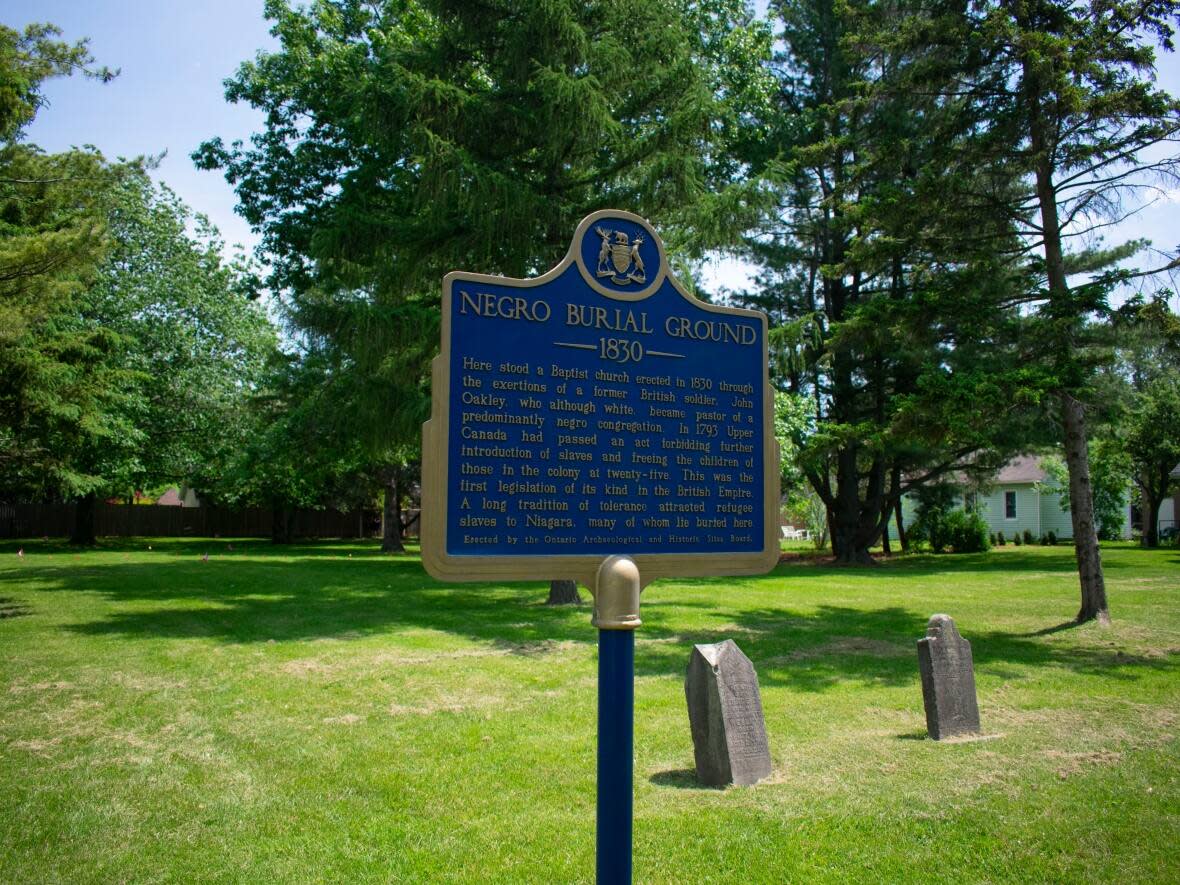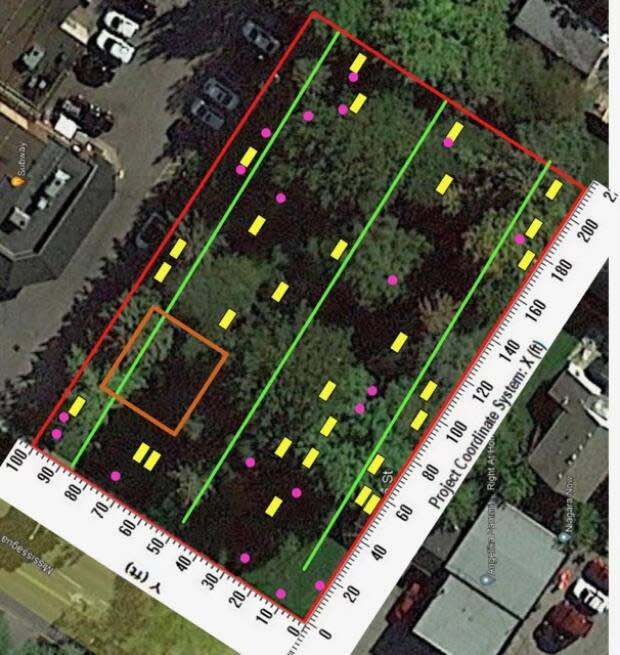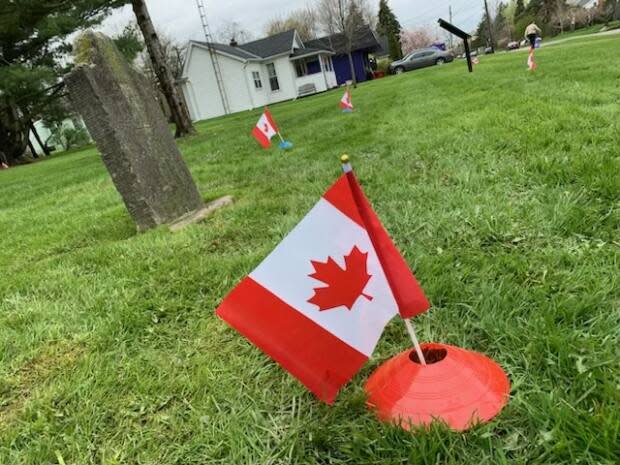Why this man wants Niagara-on-the-Lake to pay $59K to restore headstones at burial ground for Black settlers

James Russell is on a quest to restore 19 headstones buried at the Negro Burial Ground — a cemetery in Niagara-on-the-Lake that dates back almost 200 years — and have the small Ontario town foot the $59,000 bill.
The Toronto filmmaker said 28 burial sites and 19 buried headstones were detected at the cemetery in May with the help of ground-penetrating radar.
The cemetery was the burial site for mostly early Black settlers. It's not immediately clear how the headstones were buried, but Russell is adamant they could not have sunken to their current depth without human intervention.
He is pointing fingers at Niagara-on-the-Lake (NOTL) employees who he said were responsible for maintaining the site.
"Even if the town's employees laid down these headstones … There's no way in hell that those headstones managed to sink a foot and a half deep," Russell told CBC Hamilton.
"I believe they buried them because it was easier to cut the grass. That's why the Negro Burial Ground is just one grassy field. Because I believe that the town buried the headstones, I'm insisting that they pay for unearthing and restoring them."
CBC Hamilton has contacted the town, but a communications person said no member of the senior management team was available to speak.

After driving through Niagara-on-the-Lake for several years, starting in 1985, and noticing a yard with two headstones beside a small plaza on Mississauga Street, Russell decided it was time to address what he knew was more than a plain patch of grass.
"Each time I pass, I say, 'Really somebody needs to address this issue,' and finally, last November, that somebody had to be me," Russell told CBC Hamilton last June.
Determining how many buried and where
In November 2021, Russell applied to the town of Niagara-on-the-Lake for permission to use ground-penetrating radar to determine how many people were buried at the cemetery and where they were located.
According to Russell, no records were kept of names on stones and there was no mapping of those that had fallen over.

Following the discovery of the burial sites and headstones, Russell filed a complaint with the Bereavement Authority of Ontario (BAO) in December, asking that the BAO "compel the town of NOTL to unearth, restore and remount the headstones."
In the complaint, Russell reiterated it's his belief the town's employees buried the headstones, in violation of the Funeral, Burial and Cremation Services Act, and Canada's Criminal Code.
The BAO is the governing body for all cemeteries and funeral parlors in the province. Its deputy registrar, Michael D'Mello, responded to Russell's complaint on Jan. 6.
A copy of D'Mello's response was shared with CBC Hamilton. In it, he said he has contacted the manager of cemeteries for Niagara-on-the-Lake and advised of the concerns raised in the complaint.
"The Town of NOTL advised that there was no removal of existing monuments and markers from the graves in the cemetery in the last 30-plus years," D'Mello wrote.
"It appears that in the 1960s and 1970s, some municipalities moved the unstable monuments that couldn't be stabilized, into cairns [a man-made pile of stones raised for a purpose, usually as a marker or as a burial mound], to ensure their preservation and allow easier access for cutting the grass.
"In the early 2000s, cemetery operators were advised that if the interest generated from that cemetery's Care and Maintenance Fund was insufficient to allow for the stabilization of monuments, the monuments were to be laid down at the grave itself and not removed. This direction continues to be provided to cemetery operators," D'Mello added.

But Russell said it is clear the headstones were buried and not simply laid down.
He said two granite headstones in the Negro Burial Ground were placed there in 1897.
"These are huge headstones. Not one of them has sunk an inch," Russell said.
"Back in the 1800s, Black folks had no money. So, they couldn't afford marble or granite headstones. Basically their headstones were limestone and they were about the thickness of a thick book.
"The ground is clay. It's very hard. There is no way that a two-inch-thick limestone headstone that's laid down is going to sink a foot and a half. It's not possible, so it's my contention that they buried them," Russell added.
'No wilful burying or removal of monuments'
D'Mello told CBC Hamilton that based on the BAO's investigation, "there was no wilful burying or removal of monuments from the cemetery."
He said while the BAO has "no objections to restoration" of the headstones, proper authorizations must be obtained.
"It is up to the town of NOTL to decide as to the restoration of the cemetery," D'Mello said.

D'Mello also said the BAO's involvement in the matter may continue depending on the decisions made by the town.
Petition planned for spring
For his part, Russell said he will start a petition in the spring and go door to door, on his own time, for about two weeks.
He said the petition will ask Niagara-on-the-Lake "residents to sign this petition forcing the town to [pay] the $59,000 that the archeologists have given as a quote for unearthing and restoring the headstones."
Russell said Kitchener, Ont.-based Archaeological Research Associates provided the $59,000 quote last summer.
For more stories about the experiences of Black Canadians — from anti-Black racism to success stories within the Black community — check out Being Black in Canada, a CBC project Black Canadians can be proud of. You can read more stories here.



